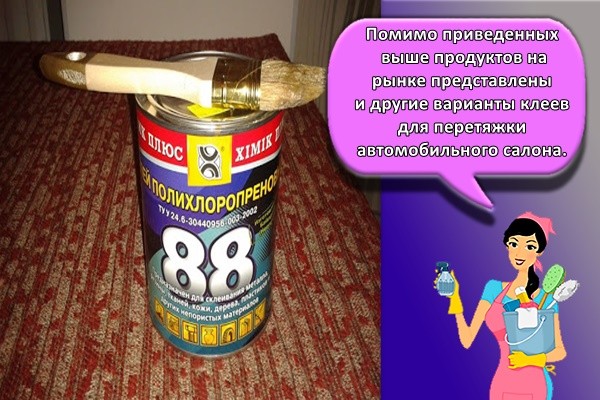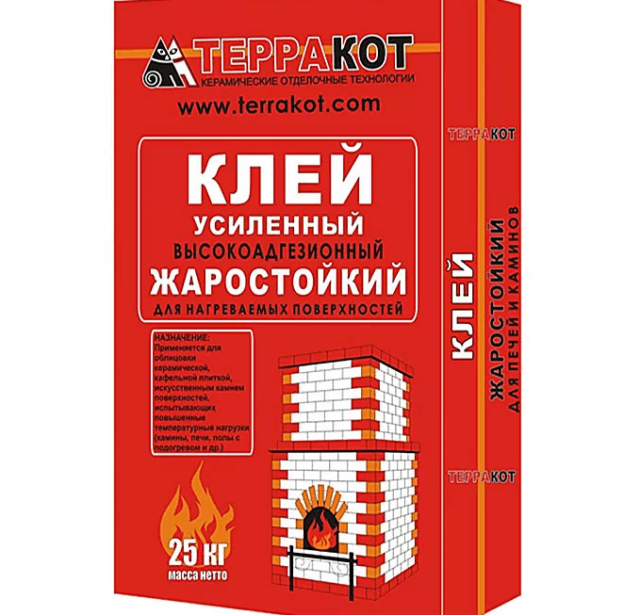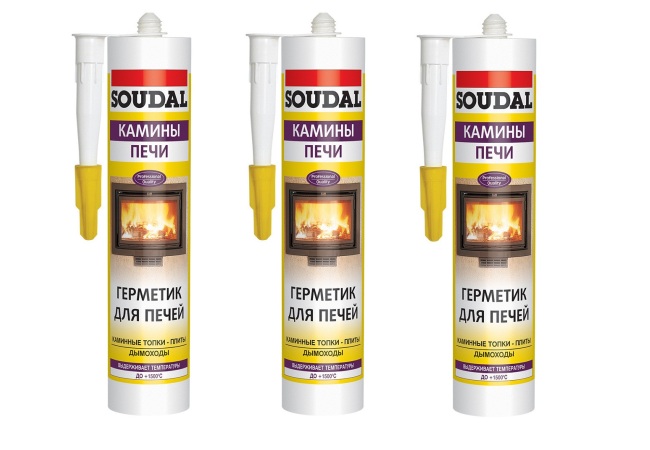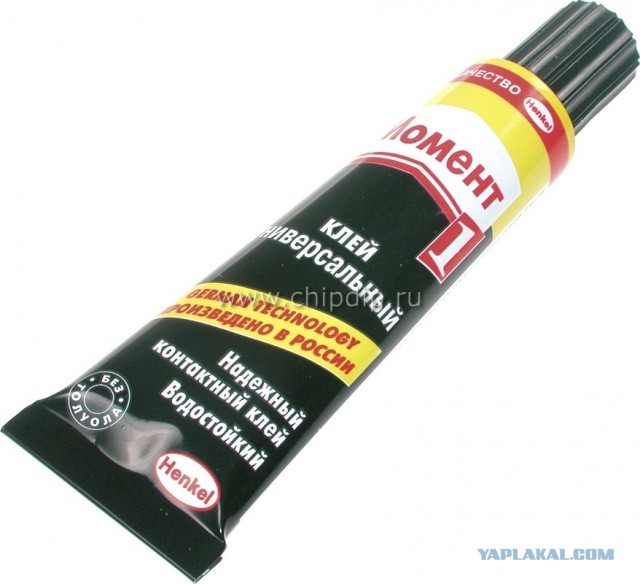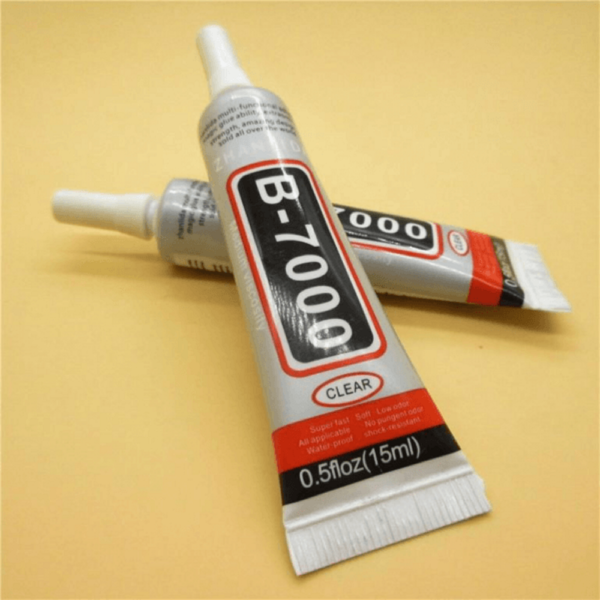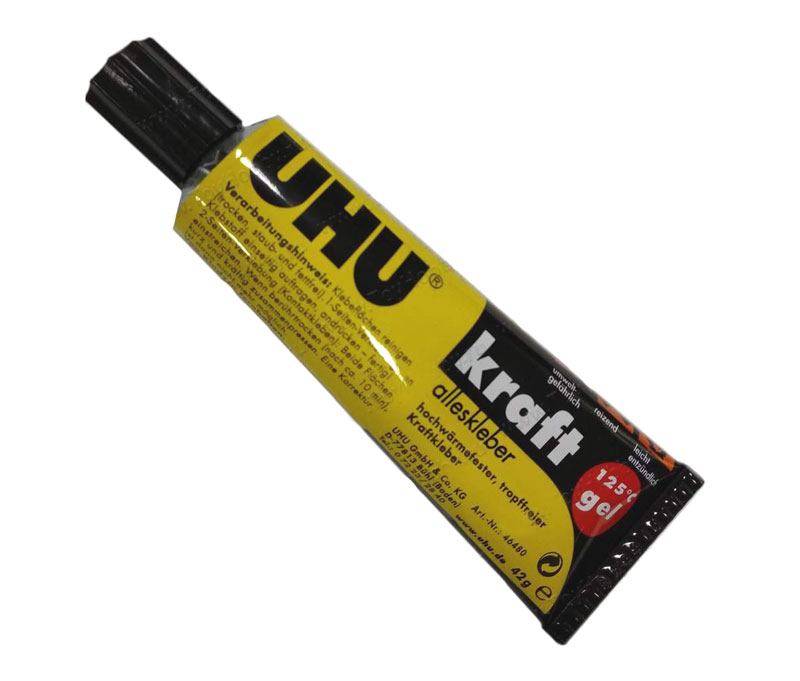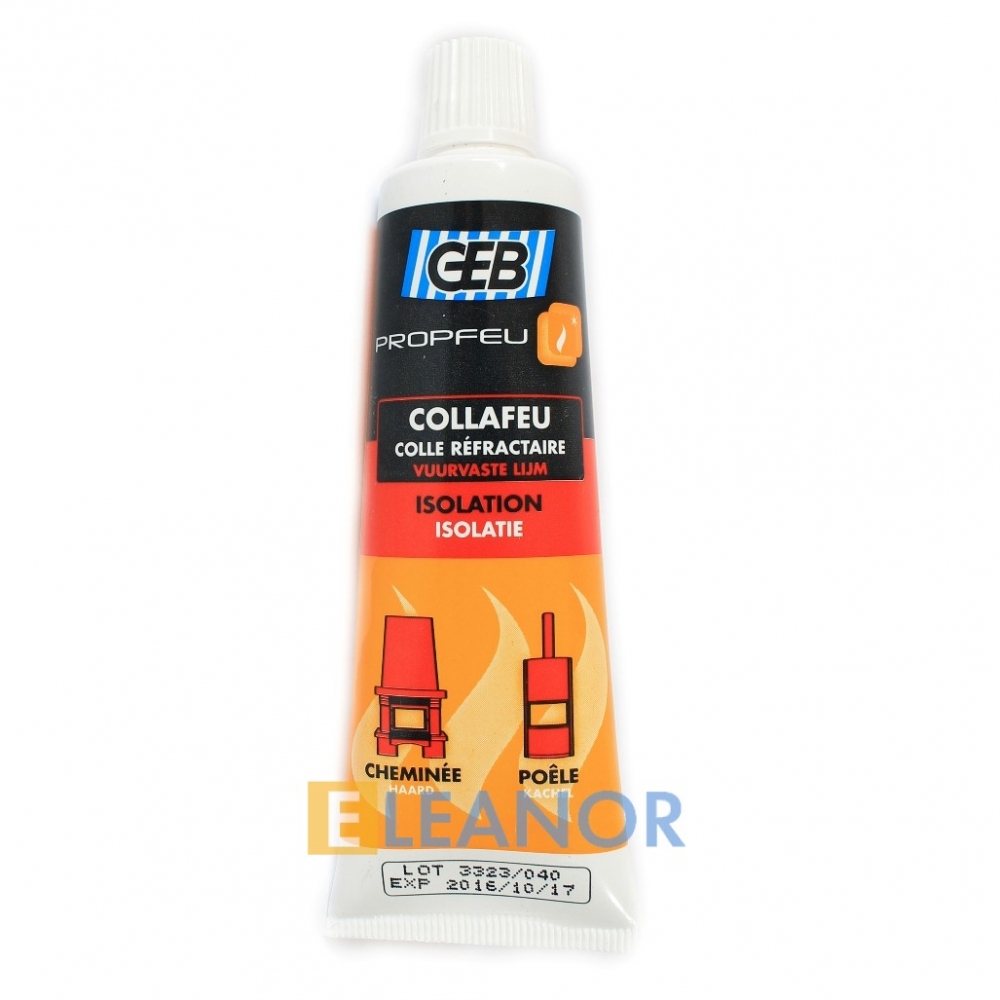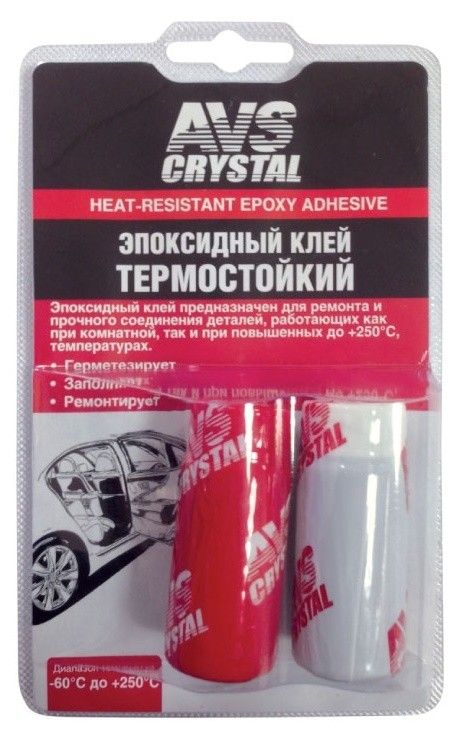Types of glass adhesives
Glass glue is made on the basis of different components. Therefore, there are several types of compositions.
Cyanoacrylate
The use of a cyanoacrylate type provides a secure fixation. The glued planes can easily be subjected to loads and vibrations. This composition has its positive aspects:
- Fast adhesion.
- Long service life of the seam to be glued.
- Application on glass surfaces with preliminary painting is allowed.
Works using this type are carried out quickly and efficiently. An example is the connection of elements in optics, microcircuits, assembly harnesses, etc.
The disadvantage is that the work must be carried out quickly, with maximum precision. Time to correct inaccuracies, there are practically no defects. Also, the glue does not withstand constant contact with water.
An example of such a composition is the cyanoacrylate adhesive Kleber CA. Designed for a wide range of materials. Treats with a professional quick-hardening composition. Dries up in 5 seconds. Forms a colorless, heat-resistant seam.
Silicone
Silicone glue can also glue the glass. Produced on the basis of high molecular weight polymer, contains additives in the form of rubber, solvent, hardener. Resistant to chemical, biological influences. There are formulations that include antiseptic components that prevent the spread of fungal formations
This is especially important if the glass product is located in damp rooms (bathroom, swimming pool, etc.). Also, water does not penetrate the seam, but collects in drops on the surface.
After complete curing on the plane with the applied adhesive, a film is formed that does not oxidize and does not lend itself to the influence of solar radiation. Silicone does not contain toxic compounds, therefore it is safe for the body. It is even used in the food industry.
It is creamy in viscosity. Drying time depends on the conditions created.
Example B-7000 is a multi-purpose compound for gluing various materials, including glass. Ease of use is ensured by a special tip that regulates the mass flow. When the seam heats up to 100 degrees, it is freed from the glue. Most often used when replacing gadget screens.
Polyurethane
It is easy to glue the glass with a polyurethane compound, since the mass is designed for gluing smooth surfaces. Available in two types:
- One-component - the mass is ready to use.
- Two-component - requires mixing with a hardener, on which flexibility when drying depends.
Composites are included in the adhesive to increase bond strength. Also included are resins and other active substances. They affect the viscosity of the material.
Example Soudal 47A is one component. Designed for gluing glass and mirror parts, indoors. It is based on rubber.
Silicate
Silicate or liquid glass - transparent glass glue. The composition contains substances used in the manufacture of glass material. Easy to use, fireproof.
The disadvantage is the speed of drying, the coatings are not subject to further staining.
Heat resistant glass adhesive
There are two types of heat-resistant glue:
- Natural base - silicate, chamotte fibers, refined sand, min. The coating can withstand heating up to 1200 degrees, while no harmful components are released into the air, so the mass is safe for the body. Can be used for household repairs (oven screen).
- Synthetic base - inorganic compounds, including phosphate, which can withstand temperatures up to 3000 degrees. Resistant to acids, used for gluing glass used in wet rooms.
TM Titan is a temperature-sensitive silicone compound that adheres firmly to glass surfaces and can withstand elevated temperatures.
UV glue for glass
In the process of polymerization of this type of glue, ultraviolet rays are involved. The compositions are used for gluing glass surfaces made of natural, organic glass with various planes and among themselves. It is based on methacrylic acid.
Provides an effective connection, heat resistance (range -40 - +150 degrees), water resistance, resistance to mechanical stress. The mass has no tone, the transparency remains when it dries completely. The composition does not include solvents, therefore it is safe for the body.
There are masses with different viscosities. For example:
- К-58ES - ultra-low viscosity (40cps).
- К-55ES - low viscosity (60cps).
- К-22В - high viscosity (390cps).
Instructions for use for tile adhesive
Such formulations are also quite easy to use. Heat-resistant reinforced glue of this type, marketed as a dry mass, is mixed with water according to the manufacturer's instructions. In some cases, a little water must be added to the pasty products of this group (if they have dried out during storage). It is best to mix the formulations of this variety using a drill. The finished mass should be as homogeneous as possible. The solutions are usually kept for 10-15 minutes before use. before swelling. Then they are mixed again.
Simultaneously, as in the case of clay heat-resistant mixtures, small portions of such glue are prepared. Tile heat-resistant compounds grab quickly enough after adding water. In any case, the prepared portion will need to be consumed within a maximum of 30 minutes.
Before applying heat-resistant glue, the surface of the stove or fireplace is thoroughly cleaned of dust, old plaster, etc. Further:
- apply glue to the tile over its entire surface with a spatula;
- keep the tile in a horizontal position for 2-3 minutes;
- press the finishing material to the surface of the oven and hold it in this position for several seconds.
If the tiles used for finishing are large, it is recommended to apply glue not only to it, but also to the very surface of the stove. It is this instruction for use that is provided, for example, for the heat-resistant reinforced glue "Terracotta".
How to work with refractory glue?
Before work, the surfaces to be mounted must be well cleaned of dust and dirt particles, because the adhesive solution interacts well only with perfectly clean and smooth surfaces. If the plane has irregularities or grooves that exceed 5 millimeters, then about a day before the start of installation, they must be compared using the same solution. It is worth noting that all bases must be primed twice (preferably with a deep penetration effect).
To dilute the adhesive base, you must read the instructions on the label, there must be clear proportions of dry components and water. There is no clear proportion that is applicable to all solutions, because each manufacturer launches a unique product on the market that has its own dilution ratios.

The dry mixture begins to be kneaded mechanically, gradually adding pure water to it, the solution must be stirred to such an extent that a homogeneous mass without lumps is obtained, after which it must be left for 5 minutes and stirred again.The resulting solution is ready for use, while it must be applied in the thinnest layer (no more than 1 mm) on a previously prepared surface, for this it is recommended to use notched spatulas of suitable sizes, and the size of the teeth should not exceed 10 millimeters.
It is worth noting that when applying, it must be borne in mind that such an amount of the mixture must be applied to the surface so that in the next 30 minutes you can have time to attach the tile, otherwise it will dry out and become unusable. Refractory tile adhesive has properties that allow you to fix the tile firmly, but if there are any shortcomings, the position of the tile can be adjusted within 15 minutes. After two days have passed, the surface is ready for use, but before that it will be necessary to grout the seams.
Advice from the masters: it is worth noting that the label, in addition to the proportion, also specifies the conditions under which the glue must be used, thus, normal conditions are a temperature not exceeding 20 degrees with a relative humidity of 60%. If the weather conditions are not favorable, that is, the temperature exceeds 20 degrees and direct sunlight falls on the surface to be installed, then the time for using the solution can be significantly reduced. If the temperature is lowered, then the setting time of the solution increases.

If the instructions are not followed, even experts will not be able to predict exactly what quality of the cladding will turn out at the end of the repair, and whether the tile will hold. You may need to clean the surface and repeat the procedure again. This will entail not only additional forces, but also financial investments.
The heating can only be switched on after two weeks from the moment the joints were planed.
When working with glue, in no case should you forget about safety precautions, since the glue solution contains cement, therefore, when diluted with water, an alkali is formed, this suggests that you need to work with it with protective gloves (gloves made of rubber) and goggles. Do not allow the solution to get into the eyes or on open areas of the skin, but if this happens, then the necessary area must be thoroughly rinsed with water.
Requirements for adhesive consistencies for finishing ovens
Tile adhesives used for tiling surfaces that are not exposed to high temperatures are not suitable for laying ceramics on stoves and fireplaces.
The action of the highest temperature causes physical and chemical changes in x, therefore, special adhesive consistencies are used for finishing the stoves with tiles with the following characteristics:
Heat resistance
Resistance to high temperatures is indicated on the packaging of the adhesive, but you should know that the glue for the installation of underfloor heating is also considered heat-resistant, but it is unsuitable for finishing fireplaces, since the upper limit of the operating temperature of such is 50 degrees, which allows it to be used only for finishing chimneys ...
The packaging must necessarily be marked "heat-resistant"
The consistency packaging must indicate the suitability specifically for lining stoves and fireplaces, that is, it must withstand a long exposure to temperatures of + degrees and short-term heating to + degrees.
High degree of adhesion
Ceramics with the highest density and low porosity (majolica, porcelain stoneware, clinker, fireclay tiles) are used for facing furnaces, while the thickness of the heat-resistant tiles must be at least 8 mm.
Strong fixation of such a veneer on the basis requires the introduction of adhesives of the highest degree of adhesion.
Elasticity
Exposure to high (up to degrees) temperatures causes thermal expansion of the furnace masonry and heat-resistant lining, but the values of these linear configurations can be different.Therefore, heat-resistant tile adhesives must have sufficient elasticity after curing to neutralize the difference in thermal expansion between the shell and the clay shell.
Safety and environmental friendliness
Under the influence of the highest temperature, almost all or their components are destroyed, evaporate, releasing toxic substances into the environment.
Tile adhesive is fire-resistant, sets extremely quickly, which makes it possible to significantly reduce the working life
Refractory compositions after curing should not have harmful gas or dust emissions.
What glass are pots made of
For the production of pots, heat-resistant glass of the Pyrex brand is used, which can withstand heating up to 300-400 degrees and a slight change in temperature. This type of cookware is suitable for cooking in the oven, microwave oven and on the hob burners.
The secret of heat resistance is in the chemical composition of the material and its thickness. The more refractory compounds are in the composition, the lower the expansion coefficient. The thicker the glass, the higher its resistance to high temperatures and overall strength.
However, in stores you can buy not only thick, but also thin glass pans. Thin-walled heat-resistant pots can withstand temperatures up to 300 degrees. They are suitable for stove and oven, but are less durable and require a neater approach. They also have a lower heat capacity, which is bad for stewing and baking.
Pans made of smoky or brown glass are no different in their properties from transparent ones. It's just a matter of taste. Transparent glass is sometimes decorated with patterns that are resistant to washing and heat. The decor makes the dishes more interesting and beautiful.
You should not look for tempered glass pots in the sale - there are none. Tempered glass is produced by rapid heating up to 600 degrees and instant cooling. This material is used in the production of glasses, wine glasses, decanters and other utensils that are not subject to heat treatment. You can put tempered glass bowls in the microwave, but not in the oven. Hardening is needed only for greater strength, it does not increase heat resistance indicators.
The most heat-resistant glass that can withstand temperatures up to 1000 degrees is not used in the production of pots. This is found in ovens, fireplaces, stoves. But progress does not stand still. Perhaps soon there will be glassware suitable for use on gas stoves without a divider.
Glass ceramics should be singled out separately - it is a durable opaque material with a smooth surface. Glass ceramics are used to make pots, braziers, baking dishes and crooks. In appearance, such crockery is similar to earthenware and porcelain tableware, but is suitable for the oven and stove.
Criterias of choice
When choosing an adhesive, it is necessary to pay attention to the compatibility of this composition with the metal to be glued. The strength of the formed layer should not be less than the strength of the metal itself
Along with the maximum temperature at which a particular composition can be used, the lower permissible term definition should also be taken into account. This will prevent the possibility of cracking and deformation of the seam in conditions of negative temperatures.
When choosing the form of release of the glue, the place of application and the type of work must be taken into account. When gluing microcracks, it is more convenient to use a liquid consistency, and plastic sticks will be indispensable in the event that it is not possible to knead epoxy resins and hardener. The most convenient to use are ready-made semi-liquid mixtures that do not require independent preparation and are completely ready for use. You should not buy glue for future use: the shelf life of many formulations does not exceed one year.
It should be remembered that even the strongest metal adhesive does not match the adhesion strength of traditional welding surfaces.If the structure is subjected to regular dynamic stress, the integrity of the butt joint will be compromised. In such cases, it is better to use welding or mechanical fasteners. If the glued part will be used at home, then there is no need to purchase expensive products with a high thermal threshold used in the aviation and automotive industries. In this case, you can get by with a budget composition with an upper term of 120 degrees.
In the next video, you will find an overview of the HOSCH two-component adhesive.
Surface treatment
If we talk about the gluing mechanism itself, then it is mainly determined by the composition. Certain compositions are supposed to be applied to the entire surface, others - only by the point method
Working with metal
 When fastening metal elements, several methods are used: gluing, welding or mechanical connection. Bonding requires adherence to a special technique, which consists in a point effect on the target surface. For such work, it is recommended to use 300 degree heat-resistant metal glue.
When fastening metal elements, several methods are used: gluing, welding or mechanical connection. Bonding requires adherence to a special technique, which consists in a point effect on the target surface. For such work, it is recommended to use 300 degree heat-resistant metal glue.
As a rule, a special epoxy thermal compound with synthetic plasticizers and additives is used to work with metal elements.
High-quality high-temperature glue for metal can withstand temperatures of the order of 370 degrees. This leads to its widespread use in the installation of warm floors. Hot melt glue is often used in the decoration of saunas, fireplaces, stoves, etc.
Glass bonding
Today, people value not only practicality, but also place increased demands on the aesthetic component. That is why, for example, household appliances are often made using various glass elements. Over time, such components may need to be adjusted. This group includes devices with a high degree of heating.
When operating under high temperature conditions, various violations of the integrity of the components may occur. Heat-resistant glue for glass with organic compounds allows you to easily, quickly and reliably solve such problems without disturbing the transparency properties of the surface.
Oven adhesive
 Until recently, clay was the main material for cladding hot surfaces. But clay is a rather messy and laborious material to work with. There are 2 types of adhesives suitable for ovens. These are heat-resistant sealants and adhesives. Both options will allow you to reliably adhere: bricks to each other (hot melt adhesives) and bricks with different materials (sealants).
Until recently, clay was the main material for cladding hot surfaces. But clay is a rather messy and laborious material to work with. There are 2 types of adhesives suitable for ovens. These are heat-resistant sealants and adhesives. Both options will allow you to reliably adhere: bricks to each other (hot melt adhesives) and bricks with different materials (sealants).
Heat-resistant adhesive for ceramics contains a special mixture of cement and sand with the addition of synthetic components. This increases the ductility and adhesive properties of such substrates.
In addition, the thermosealant is highly plastic and protects against deformation caused by heating.
When choosing an adhesive for the construction of fireplaces or stoves, one should pay attention to the toxicity of the components. With a decrease in this parameter, the amount of harmful substances released when exposed to high temperatures also decreases.
How to Choose Heat Resistant Fireplace and Stove Adhesive?
Fireplace
The hearth heats up to low temperatures, especially if used infrequently. But the furnace structure, during continuous operation, requires compositions that can work with constant heating.
Accordingly, the type of heat-resistant glue is selected depending on the operating conditions.
- For cladding a fireplace, heat-resistant adhesive mixtures are sufficient. The outer surface of the hearth does not get too hot to require more heat-resistant options. They use both cement-based compositions with polymer additives, like Cerezit, and special synthetic mixtures.
- For lining the furnace, the composition of the same category is most often used, but more durable.The structure not only heats up more, but also operates longer: one bookmark of firewood is enough for a day of work. Accordingly, all this time, the cladding must accumulate heat and give it to the room. A heat-resistant tile adhesive must withstand the constant heat action, that is, be heat-resistant.
-
The laying of the stove structure, in particular the firebox, requires the use of much more serious adhesive
mixtures. Constant heating up to +1000 C allows using only heat-resistant refractory mixtures. But using the same composition for laying tiles is economically unprofitable.
- Another application of heat-resistant glue is electric ovens and gas ovens. A rather fragile part of them is glass, or, more precisely, the junction of glass and metal. Despite the not too high heating temperature of the oven - an absolute maximum of 240 C, the sealant at the junction evaporates over time. To update it, you need a heat-resistant adhesive - Moment, for example. Can be used for glass and any heat resistant sealant for higher reliability.
Extra options
In addition to resistance to heat, adhesives for tiling or brickwork must meet some more characteristics:
coefficient of thermal expansion - under the influence of temperature, the volume of the material increases. If the coefficients of the adhesive and the material are very different, the joint will quickly fail. Complete coincidence of indicators is impossible, however, it is possible to achieve sufficient elasticity of the seam;
solution viscosity - adhesive properties. A mixture that is too high does not hold the tiles to the surface. If the viscosity is too low, the tile slides along the vertical surface;
gas tightness - combustion products should not enter the room, which means that the resulting seam must have high performance;
composition for dishes should differ in special parameters
It is important that the glue is not only heat resistant, but also food inert. Mixes for food plastic containers are selected especially carefully.
Application of heat resistant glue
In everyday life and industrial work, it often becomes necessary to use a special one for installation, which would be characterized by resistance to various types of outdoor and natural actions. The main such tool is considered to be heat-resistant glue, due to its chemical and physical characteristics, it is actively used during installation work on installing a warm floor, finishing steam rooms, fireplaces, baths, saunas, stoves. The constituents of the glue can steadily endure the action of temperature fluctuations for a long time, maintaining their original mechanical strength.
For the most effective characteristics in the glue production process, special organic and artificial elements are used, which together make a strong
Often, special fillers and refractory clay are used for the production of heat-resistant glue. Due to the presence of such a chemical composition, reliable fixation in, their endurance to the highest temperature conditions is achieved. In the process of introducing the glue, there is no need to worry that the finishes will fall off or shift over time. Manufacturers give a guarantee for this type of product for more than 10 years, but glued products using heat-resistant glue will be able to last much longer.
The main areas of use of glue.
It is mainly bought for finishing works heat-resistant glue for stoves and fireplaces.
Although at the moment, almost everywhere houses are gasified, but almost all people prefer the ancient decoration, made with the design of stoves and fireplaces. Apart from this, stoves and fireplaces will be able to do not only the role of decoration, but they can be used for their intended purpose.Therefore, for the design of such a design, finishing work is required, the installation of which is not feasible without special glue. Heat-resistant glue will help with this, after using it, you will not have to worry later that when the fire is kindled, something from the parts of the decor will fall off.
Scope of application of heat-resistant glue
Craftsmen use heat-resistant glue not only for gluing, but also as a sealant.
The sealing compound, which is based on heat-resistant silicone, is very convenient for filling joints, gaps in the chimney. It is also used in the repair of household heating appliances.
For electric and gas ovens
If you still do not know how to glue the glass in the oven, then there will be heat-resistant glue. Some sealants are fire resistant. These include Makroflex refractory sealant. It is more effective than any other material in repairing cracks and joints in electric ovens and braziers.
Heat-resistant glue Moment has won high popularity. It is in demand when gluing various materials: glass, ceramics, porcelain, plastic, leather.
For tiling
The range of use of adhesive mixtures resistant to high temperatures is very wide. But most often they are used as a tile adhesive.
- cement;
- sand;
- polymer additives that impart adhesive properties to the mixture.
Heat resistant oven tile adhesive can be polyurethane or epoxy based. The one and the other type of mixture consists of two components that are in the package. They should be mixed just before use in accordance with the indicated proportion.
For fireplaces and stoves
The choice of glue and heat-resistant sealant for ovens should be based on their area of application.
Furnaces and fireplaces are decorated with a thermally conductive adhesive that can withstand temperatures up to 125 ° C, but with high thermal conductivity. When performing facing work, it is necessary to exclude slipping of the tiles. Therefore, a mixture of increased fixation is used, which allows facing in different directions, including from top to bottom. And when laying bricks, you need a high-temperature oven adhesive that is heat-resistant up to 1400 ° C.
Price and economical consumption are of great importance when choosing an adhesive. Customers like it when this product is offered in a ready-to-eat consistency, with a variety of packaging options, and consumption rates are indicated on the packaging.
On average, a surface of 1 m² requires 1.5 kg of mixture with a mortar application thickness of 1 mm. In practice, these figures can be higher, especially if the area to be glued is not perfectly flat.
Various adhesives are referred to as universal means with connecting characteristics. Today, the industry produces a variety of types of adhesives. They all have their own specific properties. One of the groups of such bases includes heat-resistant adhesives designed to work with a wide temperature range.
Views
The properties of a heat-resistant mixture are determined by their composition. The main types of heat-resistant glue:
- For the installation of underfloor heating systems. Such products can withstand temperatures up to 50 degrees. This type of glue is not suitable for lining stoves and fireplaces.
- For finishing fireplace and stove structures. This type of formulation can easily tolerate temperatures up to 1200 ° C.
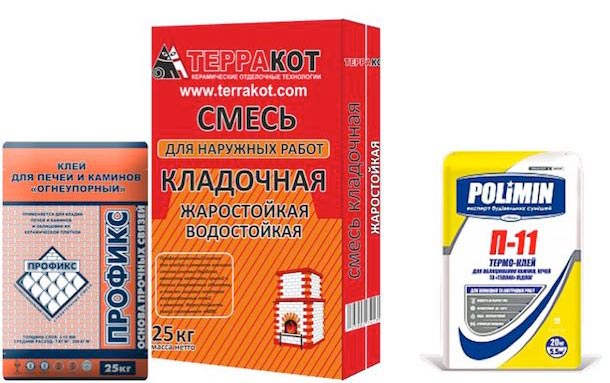
In addition, heat-resistant mixtures can have a different form of release:
- Liquid composition. This hot melt glue has a jelly-like structure. Most often, these materials are ready for use immediately after opening the package.
- Powder. Before use, a sticky solution must be prepared from the powder. To do this, use the instructions that should be on the package.
The difference between heat-, fire- and heat-resistant glue
Most often, experts prefer universal types of glue.This allows you to speed up work and meet all the needs of the customer. If we consider each type of glue separately, we can highlight the following features:
- Heat-resistant - able to calmly withstand prolonged exposure to temperatures up to 140 ° C.
- Heat-resistant adhesive - withstands temperatures up to 1000 ° C.
- Refractory mixes - withstand exposure to open flame for at least 3 hours. Such formulations are highly resistant to chemicals.
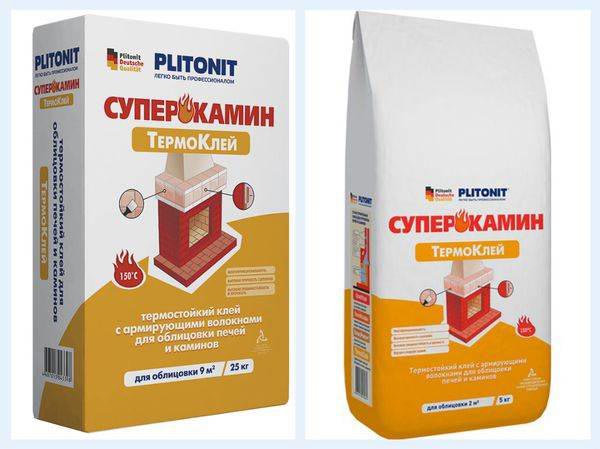
Adhesive for laying the base of the fireplace
Fireplace adhesives can contain cement, clay and sand. They are less elastic than the other types, therefore it is undesirable to use them for the purpose of cladding.
Under the influence of high temperatures, the form of substances changes - they expand. When cooled, they narrow again.
If the materials have the same composition, then the coefficient of contraction / expansion will be the same, which minimizes the risk of cracking.
Fire retardant adhesive for fireplace cladding
If the fireplace needs to be finished with stone or tile products, you can use a special glue, which is dominated by minerals that provide increased adhesion and elasticity.
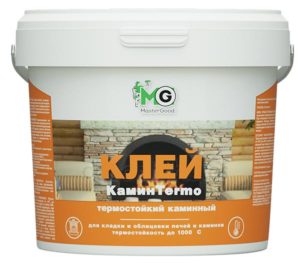
The use of such mixtures minimizes the risk of tiles (ceramic tiles) falling off during the subsequent operation of the oven.
To correct the surface of fireplaces and stove structures, soapstone powder based on water glass is often used. Such compositions are called Finnish and have an increased heat transfer, so the fireplaces, for which it will be used for facing, will quickly heat the room.
In addition, Finnish hot-melt mixtures are extremely malleable when exposed to high temperatures.
What glue is right
Some materials (in particular, the carpet) are produced with a self-adhesive backing. In this case, you do not need to buy additional compounds to fix the new skin. If there is no such base, then you will have to choose the appropriate glue, taking into account the technical characteristics of a particular product. The properties of the composition are determined depending on the components contained.
Polychloroprene based
This product is based on various resins and metal oxides, thanks to which the polychloroprene-based adhesive provides strong and durable fixation. This composition is applied to both surfaces (on the material and the surface to which it is glued).
Polychloroprene based adhesives include:
- "Clay-88";
- "Mah";
- GTA Boterm.
Choosing a glue based on polychloroprene, you need to take into account that this product does not tolerate a temperature rise of up to 60 degrees. With this effect, the compound begins to melt, due to which the degree of fixation decreases, and carcinogenic substances enter the salon.

Despite the above disadvantage, this composition is quite popular among motorists. This is explained by the fact that after gluing the casing, the machine can be used after half an hour.
Polyurethane
Polyurethane compounds are considered the most optimal for the constriction of car interiors. Products of this type belong to the universal group. That is, polyurethane glue can be used to fix different types of materials. This composition hardens for a long time, due to which, if necessary, it is possible to eliminate the disadvantages of fastening the skin.
Polyurethane adhesives include:
- "Demoskol";
- "Moment";
- "Titanium";
- Kaiflex K414.
Employees of service centers recommend that motorists who have not previously been involved in interior hauling should use only polyurethane-based adhesives.
Other alternatives
In addition to the above products, there are other variants of adhesives for car interior upholstery on the market. To facilitate future work, it is recommended to purchase formulations that meet the following characteristics:
- easy to use;
- do not spoil the finishing material and do not flow;
- distributed in a thin layer over the surface;
- do not form lumps;
- smooth the sheathing;
- dry quickly;
- do not penetrate deeply into the fabric, imprinted on the back.
Aerosol adhesives are considered the best choice for upholstery. These products exactly match the above specifications.
